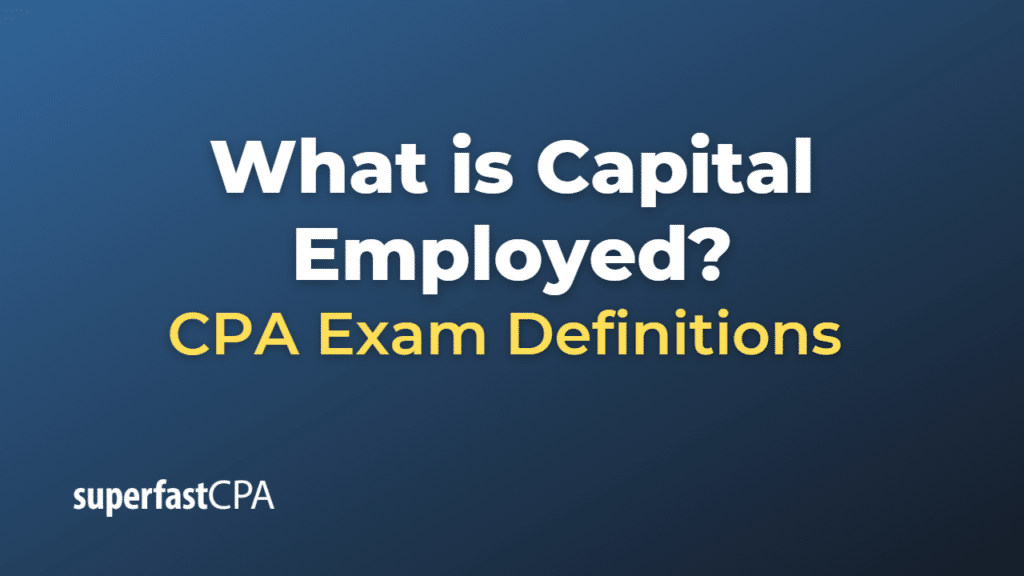Capital Employed
Capital employed is a financial metric that measures the total amount of capital invested in a business, including both equity and debt financing. It represents the resources used by a company to generate profits and create value for its stakeholders. Capital employed is an important metric for analyzing a company’s performance, efficiency, and financial structure.
There are several ways to calculate capital employed, but two common methods are:
- Total Assets – Current Liabilities: This method considers all the assets used in the company’s operations, excluding current liabilities that need to be settled within a year. It represents the long-term capital invested in the business.
- Equity + Long-term Liabilities: This method calculates capital employed by summing up shareholders’ equity (including share capital, retained earnings, and other equity components) and long-term liabilities (such as long-term debt and other long-term obligations). It represents the sources of financing used by the company to fund its operations and growth.
Capital employed is often used in financial ratios to evaluate a company’s performance, such as Return on Capital Employed (ROCE) and Operating Profit Margin. These ratios help investors and analysts assess how efficiently a company is using its capital to generate profits and create value.
For example, the ROCE ratio is calculated by dividing a company’s operating profit (or EBIT) by its capital employed. A higher ROCE indicates that a company is generating more profit per dollar of capital invested, which suggests better efficiency and profitability. Conversely, a lower ROCE may indicate that a company is not utilizing its capital as effectively and could be a cause for concern.
In summary, capital employed is a measure of the total resources used by a company to generate profits and create value. It provides insight into a company’s financial structure and performance and is a key metric for evaluating its efficiency and profitability.
Example of Capital Employed
Let’s consider a hypothetical example of two competing technology companies, TechAlpha and TechBeta, to illustrate the concept of capital employed and how it can be used to evaluate their performance.
Suppose the following financial information is available for both companies:
TechAlpha:
- Total Assets: $5,000,000
- Current Liabilities: $1,000,000
- Shareholders’ Equity: $3,500,000
- Long-term Liabilities: $500,000
- Operating Profit (EBIT): $1,200,000
TechBeta:
- Total Assets: $8,000,000
- Current Liabilities: $2,500,000
- Shareholders’ Equity: $4,000,000
- Long-term Liabilities: $1,500,000
- Operating Profit (EBIT): $1,600,000
We can calculate capital employed for each company using the two common methods mentioned earlier:
- Total Assets – Current Liabilities:
- TechAlpha: $5,000,000 – $1,000,000 = $4,000,000
- TechBeta: $8,000,000 – $2,500,000 = $5,500,000
- Equity + Long-term Liabilities:
- TechAlpha: $3,500,000 + $500,000 = $4,000,000
- TechBeta: $4,000,000 + $1,500,000 = $5,500,000
(Note that both methods yield the same results in this example.)
Now, we can calculate the Return on Capital Employed (ROCE) for each company:
- TechAlpha ROCE: $1,200,000 (Operating Profit) / $4,000,000 (Capital Employed) = 0.3 or 30%
- TechBeta ROCE: $1,600,000 (Operating Profit) / $5,500,000 (Capital Employed) = 0.2909 or 29.09%
Although TechBeta has a higher operating profit, TechAlpha has a higher ROCE, indicating that it is more efficient in generating profit from its capital employed. This could suggest that TechAlpha is utilizing its resources more effectively than TechBeta.
In this example, capital employed is used to evaluate the performance of two competing companies. By comparing their ROCE ratios, investors and analysts can gain insight into how efficiently each company is using its capital to generate profits and create value for its stakeholders.













